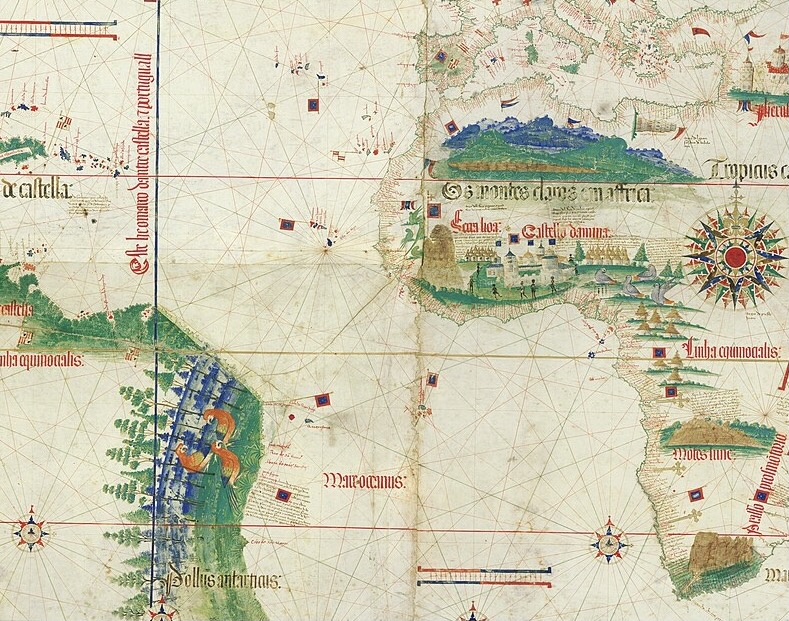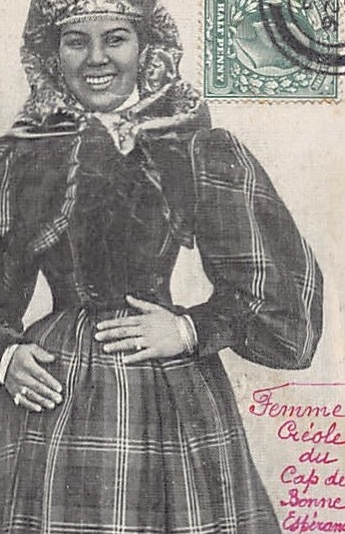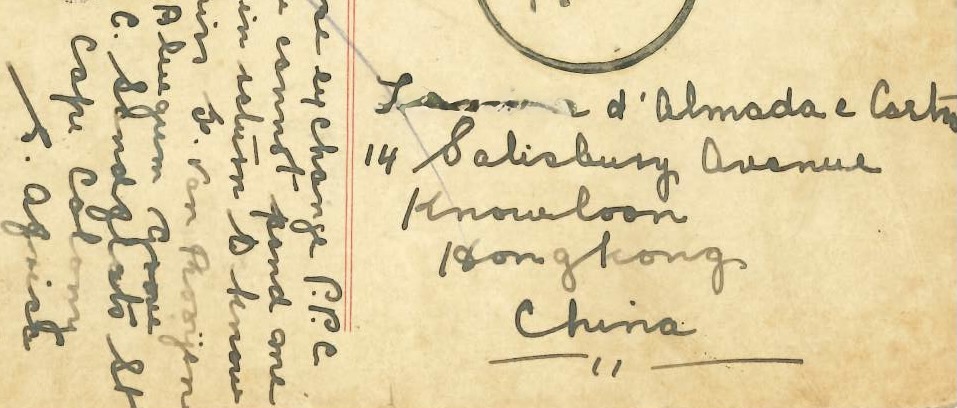The early 20th century was the golden era of postcards. Not only did travelers buy postcards as souvenirs, but strangers also exchanged postcards in order to know more about other cultures. For example, the featured image above was a postcard sent from the then British Cape Colony to a Portuguese living in Hong Kong in 1909. The cancellations on the postcard were Sandflats (10 March), Calcutta (15 April), and Hong Kong (4 May). At the time of the mail, all three places were British possessions. However, the routes that connected these places should be credited to the pioneers of globalization – the Portuguese navigators.
The story began in the 15th century – a time of the advent of maritime technology and exploration, and the Portuguese were in the lead. In 1488, the Portuguese navigator Bartolomeu Dias (c.1450–1500) discovered a cape located at the southern tip of the African continent. The cape was named Cabo da Boa Esperança in Portuguese, i.e., Cape of Good Hope – a name that symbolized people’s optimism in finding a sea route to the East. In the history of maritime trade, the discovery was a turning point because it marked the beginning of global commerce that extended across Europe, Africa, and Asia. Since the land route was controlled by the Ottoman Empire, the water route proved to be the most important alternative for the next several centuries.
The next milestone in seafaring history was the “discovery” of the New World by Christopher Columbus (1451–1506). Columbus studied astronomy, cartography, and navigation in Lisbon and started his seagoing career there. He advocated for a direct water route to Asia by sailing west across the Atlantic Ocean. The idea, though denied by the Portuguese officials, received support from Ferdinand of Aragon and Isabella of Castile in Spain. The expedition started in 1492 from Spain and, as we now know, landed on the Caribbeans, then called the West Indies. Though Columbus never reached Asia, his four trips made between 1492 and 1502 drastically changed the history of the Americas.
The news of the discovery of new lands created disputes between Portugal and Spain over rights to the resources of the New World. Consequently, without the participation of other nations, the two empires agreed to divide the New World by drawing a pole-to-pole line of demarcation 370 leagues (1786 km) west of the Cape Verde Islands, then controlled by Portugal. This was known as the Treaty of Tordesillas (1494), which ratified that Portugal would claim all lands to the east of the demarcation line and Spain all lands to the west of the line.

Following Dias’s route, Vasco da Gama (c. 1460–1524) rounded the Cape of Good Hope, sailed up the eastern coast of Africa, crossed the Indian Ocean, and eventually arrived in Calicut (Kozhikode) of India in 1498. Subsequent expeditions resulted in the occupation of Cochin in 1502 and Goa in 1509. This was not only a navigational triumph for the Portuguese, for hundreds of years that followed, but also for other Europeans who travelled the route numerous times to bring highly prized spices like black pepper, cinnamon, ginger, saffron, etc. back to Europe. Apart from economic gains, the Europeans also exerted political domination over the Indian subcontinent at different periods.
The journey to the East did not end there. In 1511, Afonso de Albuquerque took over Malacca as a trading post. Passing through the Straits of Malacca, the Portuguese navigators continued their explorations into other parts of Southeast Asia such as Malaysia and Singapore. In 1512, the Portuguese fleets visited the Indonesian Archipelago and Maluku Islands – the Spice Islands. Jorge Álvares made the first attempt to visit China in 1513. His ships reached a place known as Tamão in the Pearl River Delta, Canton (now Guangzhou). However, it was not until 1557 that the Portuguese were allowed to settle in Macau, approximately 60 kilometres from Hong Kong. In East Asia, Portugal-Japan Nanban trade began in 1543.
The Portuguese explorer Ferdinand Magellan (1480–1521) sought a westward passage to the Spice Islands. Under the sponsorship of Spain, Magellan crossed the Atlantic Ocean in 1519 and sailed down the eastern coast of South America, where he discovered a channel going through Argentina and Chile, now named after him as the Strait of Magellan, that gave a quick passageway to the Pacific Ocean. Magellan’s fleet reached the Philippines in 1521. However, Magellan was killed in Mactan of the Philippines. Led by Juan Sebastián Elcano, the rest of the sailors crossed the Indian Ocean, rounded the Cape, and returned to Spain in 1522. This was the first circumnavigation of the world.
The Age of Exploration was an era in modern history where people, culture, trade, and religion had never been so closely interconnected and interdependent. In language history, the period between the 15th and 19th centuries was the heyday of language creation. An example is Afrikaans, currently one of the 12 official languages of South Africa. Though discovered by Portuguese navigators, the first Europeans who settled at the Cape of Good Hope were the Dutch. In 1652, the Dutch East India Company or Vereenigde Oost-Indische Compagnie (VOC) set up a refreshment station in Table Bay (later known as Cape Town), where their ships could get fresh water and food and other supplies to continue their voyages to the Dutch East Indies. During the VOC rule, the supply station gradually became a Dutch settler community. These early settlers, also called the Boers (farmers), were the ancestors of the present-day Afrikaners.

Soon after the establishment of the colony, people from Madagascar, Mozambique, India, Ceylon (Sri Lanka), and the Dutch East Indies were imported to work as slaves on the farms. Over time, a distinct language known as Afrikaans was formed and used as a lingua franca in the multilingual colony. While most words are etymologically Dutch, the languages of the slaves and the indigenous people Khoisan also contribute to the development of Afrikaans. Some researchers argue that Afrikaans is a dialect of Dutch; others propose that it is a semi-creole. A major group in the Cape Colony was the Cape Malays. Cape Malays is a catch-all term referring to people from Southeast Asia, specifically Indonesia. While the Cape Malays might not be ethnically Malay or speak Malay natively, Malay was used as a lingua franca among them and most of the Cape Malays were Muslims. It was through the Cape Muslim community that Islam was brought to South Africa. Recent studies show that early Afrikaans texts of the 1820s were written in Arabic script and Latin script was adopted around the 1850s. The presence of Malay can still be found in the lexicon of Afrikaans.2
Britain took over Cape Town from the Dutch in 1795, and after a short return to the Dutch in 1803, Britain reoccupied it in 1806. The Union of South Africa, a self-governing dominion of Britain, was created on 31 May 1910.
1. van Sluijs, Robbert. 2013. Afrikaans. In Susanne Maria Michaelis, Philippe Maurer, Martin Haspelmath & Magnus Huber (eds.) The survey of pidgin and creole languages. Volume 1: English-based and Dutch-based Languages. Oxford: Oxford University Press. Online version: https://apics-online.info/surveys/29
2. Davids, Achmat. 2011. The Afrikaans of the Cape Muslims from 1815 to 1915. Hein Willemse and Suleman E. Dangor (Eds.). Pretoria: Protea Book House.
